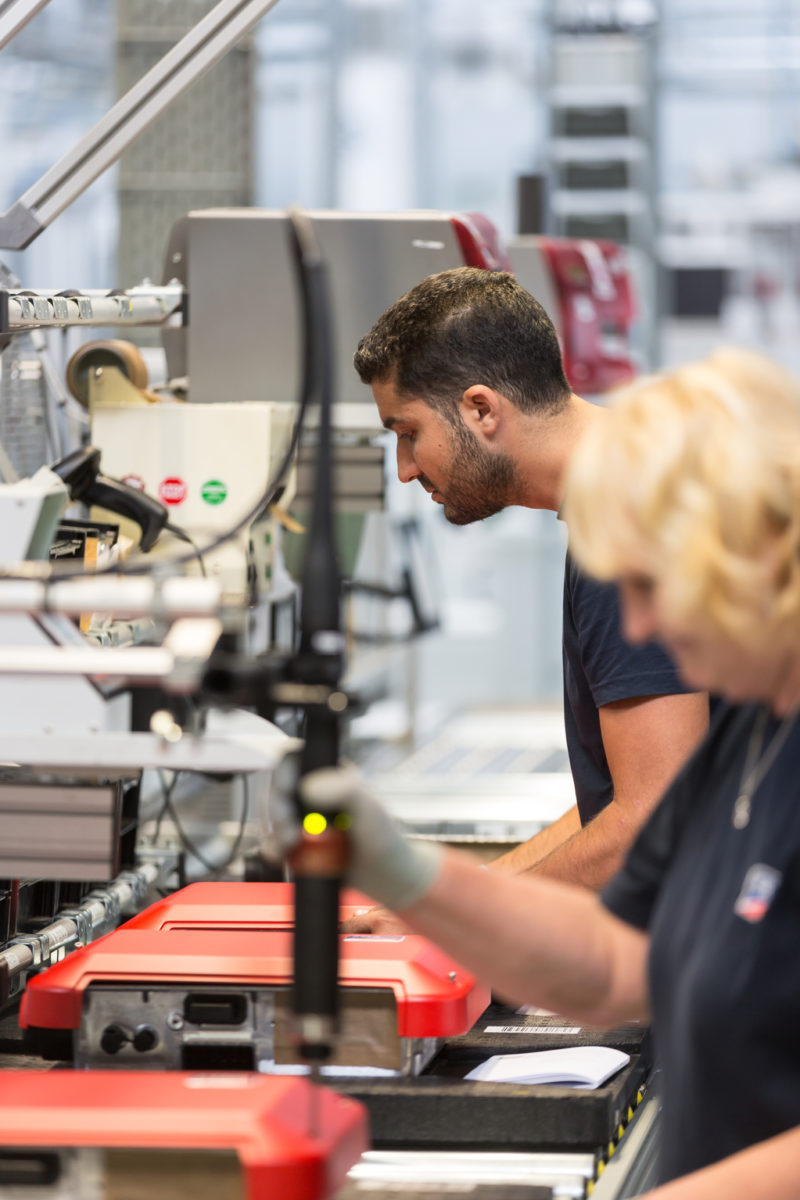What does sustainability mean to SMA?
Sustainability has been a core value of SMA and an essential part of our corporate mission statement ever since the company was founded back in 1981. Right from the beginning, we firmly believed that it is not enough only to develop and produce solutions for the production of clean energy, but that it is also extremely important that these solutions are produced, used and recycled in a way that is sustainable over the whole value chain. Therefore, we have always understood sustainability as combining long-term economic success with protection of the environment and social responsibility.
Does the company publish regular sustainability reports, which quantitatively measure impact, emissions, energy use, water and waste; and which compare progress from year to year? Please provide concrete examples of how progress has been achieved.
Yes, we publish non-financial statements including sustainability key figures on an annual basis. In these, we report on our sustainability strategy, activities and achievements using the internationally respected Global Reporting Initiative (GRI) standard. The standard ensures that we inform our stakeholders with highest transparency and comparability based on commonly accepted principles about the developments and the progress we made in terms of sustainability in the respective year.
We are very proud of the progress that we have achieved in several areas over the last years. For example, we have nearly cut in half the energy consumption as well as the CO2 emissions per produced kilowatt of inverter output between 2015 and 2018. We have also increased the amount of self-produced solar power in our total electricity consumption from 32% to 40% within the same period of time. By the way, in Germany we exclusively use renewable energies for our power supply.
We have also used our high innovation capabilities to substantially increase the material efficiency of our inverters. Whereas in 2017 the weight of our string inverters had averaged 3.4 kg/kW output, in 2018, this fell to just 2.97 kg/kW. In our central inverters, we increased the power density such that the new Sunny Central UP produces over 50% more power with the same weight and volume as the Sunny Central 3000-EV, previously SMA’s most powerful inverter. The high power density also reduces the number of inverters required within a PV power plant, which not only saves resources, but also our customer’s money.
How do you quantitatively ensure that external partners in your supply chain are operating sustainably?
As early as 2009, SMA signed the cross-sector code of conduct issued by the German Association of Supply Chain Management, Procurement and Logistics (BME e.V.). In 2010, we supplemented this code of conduct with SMA’s own guidelines for suppliers. This SMA supplier code covers topics such as corruption, antitrust law, ethical principles, labor standards and employee rights, environmental protection, quality and product safety. Suppliers must sign the SMA supplier code on conclusion of a contract.
We evaluate our entire supply chain’s sustainability performance using the internationally respected EcoVadis rating. Supplier participation in the evaluation is mandatory. We have already evaluated suppliers corresponding to around 90% of our goods volume.
What recycling programs are currently in place? How do you ensure all inverters are safely returned and recycled?
Currently, there is no regulation in place that requires all inverters to be returned to their producers. So, we can’t ensure that all inverters are returned to SMA. However, by applying the highest standards in development, design and production of our inverters, we ensure their high quality and longevity. High-quality inverters can be relied upon to do their duty over the years, even under the harshest conditions. We have inverters in the field that are still running perfectly after 25 years. This benefits both our customers and the environment.
Second, we ensure to deal sustainably with and take back inverters that are still under SMA warranty. If an inverter fails, we try to repair it on-site instead of just replacing the whole inverter like some of our competitors do. If a repair is not possible and the inverter has to be replaced, we use a reconditioned device for the replacement and take the defect inverter back to repair it in our service repair center. With inverters that can’t be reconditioned and transferred to our replacement device pool we try to recover as many raw materials as possible.
How does it vary from market to market? What improvements need to be made?
German regulations like the “kreislaufwirtschaftsgesetz” are quite good in ensuring that recycling is done by certified specialist companies. It would be desirable to have such regulation in other markets, too.
What toxic materials does SMA deal with in (i) production processes and (ii) recycling processes; and how are they safely dealt with?
In general, we don’t process any such substances in our production process, but our inverters use components that can contain these substances. Of course, we act in accordance with material requirements such as the REACH (Registration, Evaluation, Authorisation and Restriction of chemicals) Directive and the RoHS (Restriction of the use of certain Hazardous Substances in electrical and electronic equipment) Directive.
Examples of substances that may occur are lead in welding (in our production, we do lead-free welding), cadmium that might be contained in switching elements, or Phthalates that might be used as plasticizer in cables. As mentioned, we avoid directly using these substances, but cannot completely rule out that they might be contained to a minimum extent that goes below the RoHS limits in some components used in our inverters.
We also expressly welcome the Dodd-Frank Act on conflict minerals and have volunteered to comply. Thereby we guarantee that we don’t use any conflict minerals in our inverters.
What plans are in place to reduce/replace toxic substances?
As just said, these substances are used only to a minimum extent in our inverters, and we are constantly working to further reduce the use of critical and rare substances. Our standard for the use of hazardous substances was adjusted again last year. In addition to the requirements of the Montreal Protocol, SMA introduced its own restrictions on additional materials, like silver. We have called on all suppliers to comply with the standard. In our product development process, we are currently developing further criteria for materials to be excluded or reduced to make our products even more sustainable.
It is important for us to keep the environmental impact of our products as low as possible, beginning in the development phase. Our guidelines for sustainable product design therefore lay down key requirements that ensure our products become more sustainable from one generation to the next. The definition of the aforementioned “non-preferable materials” also contributes to sustainable design. Efforts to avoid these materials, which pose environmental or health risks or whose production might involve a violation of human rights, are to be taken into consideration in the pre-development stage and tracked through to the preliminary supply chain. A key figure shows the improvements in each individual area. To reach this figure, we consider all stages of the value chain.
Creating a circular economy is “hugely important” to SMA. What is the company doing to achieve this? Please provide examples.
We are currently developing a comprehensive strategy aimed at achieving a circular economy in our complete value chain. This strategy combines the topics of “non-preferable materials”, “design for recycling” and reusing as many materials as possible after the end of our inverters’ service life. Measures like the guideline for sustainable product design are part of the strategy. We have also conducted product life cycle assessments in recent years for inverters in the Sunny Boy, Sunny Tripower and Sunny Central product families. These help us finding the greatest possibilities within our value chain, define the right goals and continuously improve our product sustainability key figure.
Is SMA part of any schemes, like the Carbon Disclosure Project or Declare Label? If not, is this something the company will undertake? Please elaborate.
We are part of various schemes, the most important of which is the UN Global Compact that we have signed in 2011. Initiated by the United Nations, this scheme is based on voluntary CEO commitments to implement universal sustainability principles and to support UN goals. Based on the ten principles of the Compact and on the 17 UN Sustainable Development Goals, we continuously develop our commitment to sustainability.
We are not yet part of the Carbon Disclosure Project, but we transparently map our carbon Footprint by collecting data in accordance with the strict GHG Protocol Standard. The data collected and published includes the whole company operations, from production through to administration, sales, service and development, and also business travel and logistics. Our long-term plan is to expand this to the entire value chain and also factor in the production of raw materials, all our suppliers, the utilization phase and recycling of our products.
 Finally, why did SMA decide it was important to support pv magazine’s new UP sustainability campaign?
Finally, why did SMA decide it was important to support pv magazine’s new UP sustainability campaign?
As already mentioned, SMA has been convinced from the very beginning that it is very important for companies, especially in our industry, to be sustainable in all aspects. We can’t be credible, if we say that it is enough that we produce solutions for renewable energies. It is as important that we produce these solutions sustainably across the whole value chain and that companies are transparent in what they are doing. Therefore, it is important for each company to report on its own about its sustainability measures based on internationally respected standards. But it is also important to report in a campaign on what is done in the industry.
I am well aware that not all companies in the industry share our strict views on sustainability, but I think that the UP campaign will stimulate them to rethink their approach. I am convinced that our sustainability engagement will pay out as sustainability becomes ever more important with customers and society – and I think that this is a good sign for the future.
This content is protected by copyright and may not be reused. If you want to cooperate with us and would like to reuse some of our content, please contact: editors@pv-magazine.com.




I applaud your effort to engage and support sustainability with product and your network partners.
I am somewhat confused by the statement regarding SMA inverters that are out of warranty. What will happen to these orphan products that are not repaired and put back into service but simply disposed of ?
While Working with SMA in the early days
we deployed hundreds of thousands of SMA inverters into the field and now many of those systems are well over 10 years old and some of them are nearly 18 years old .
Our current company prides itself by helping others to recycle and replace their solar products in a truly sustainable way.
We process thousands of inverters and solar modules on annual basis and are happy to do so.
One of the biggest issues that we find is that the end-user and the installers are ill-equipped or not in formed how to recycle or process the older solar products. In the USA more than 90% of older solar systems that are decommissioned are not recycled.
We need the solar industry help educate, support, and make the Solar business truly sustainable and move towards a circular economy !
Hi Sam, As the interview points out, there is no legislative requirement on SMA to collect end-of-life inverters or on project owners to return them to SMA.